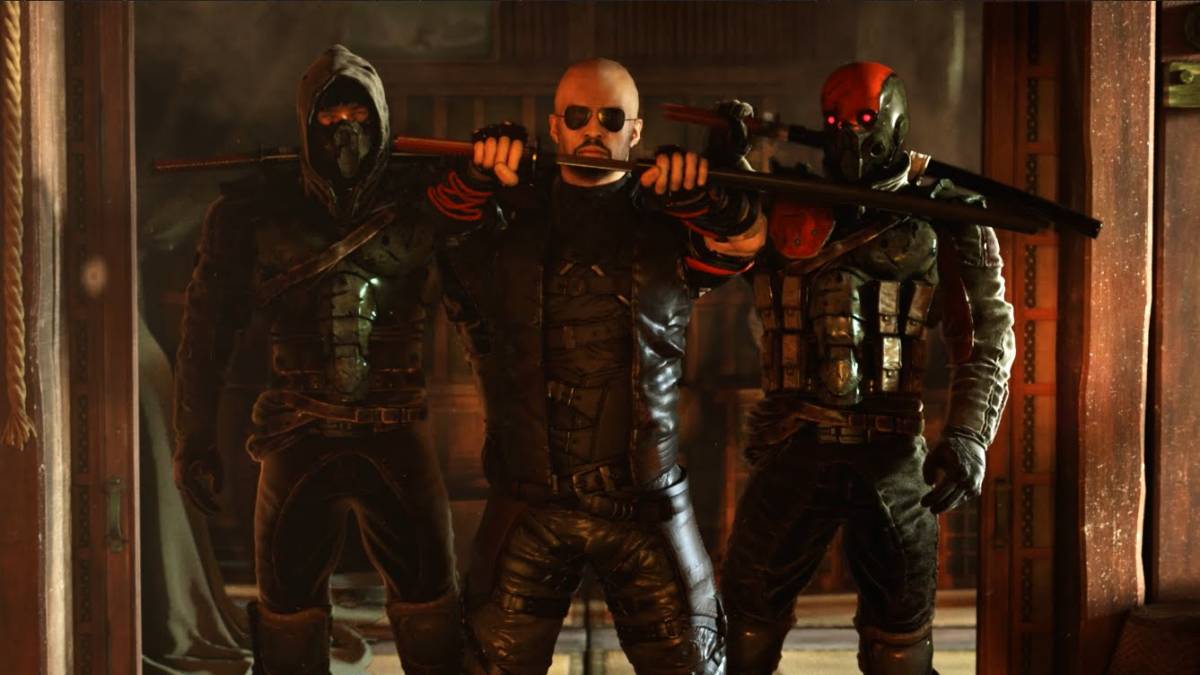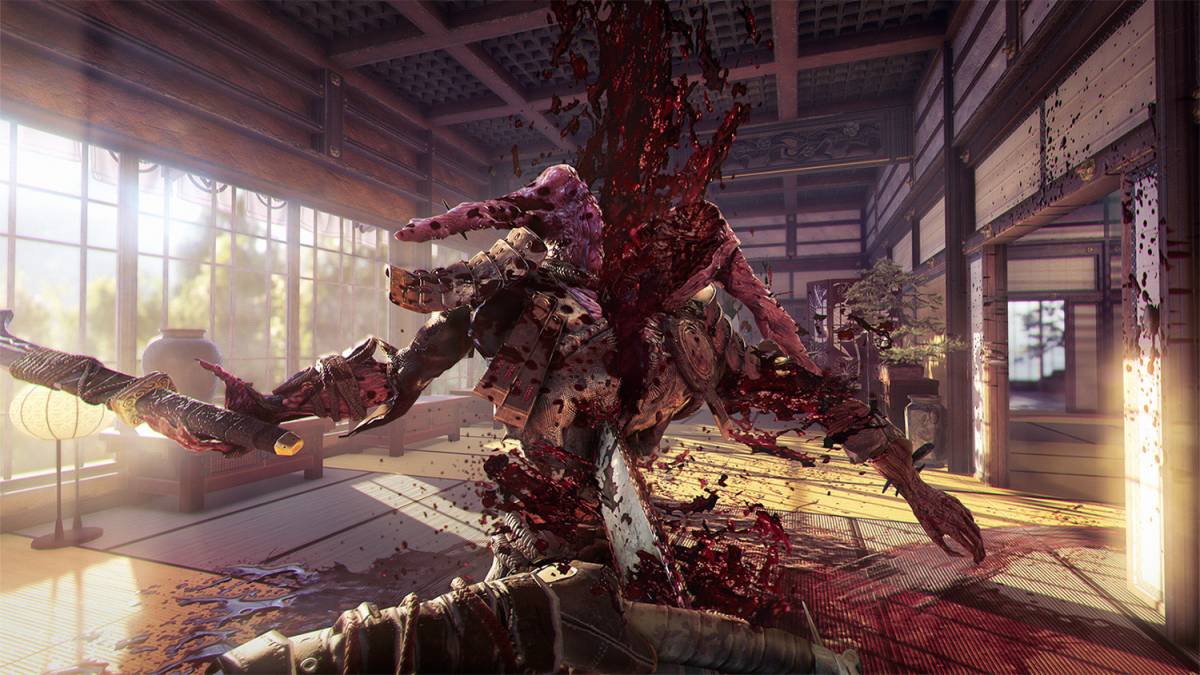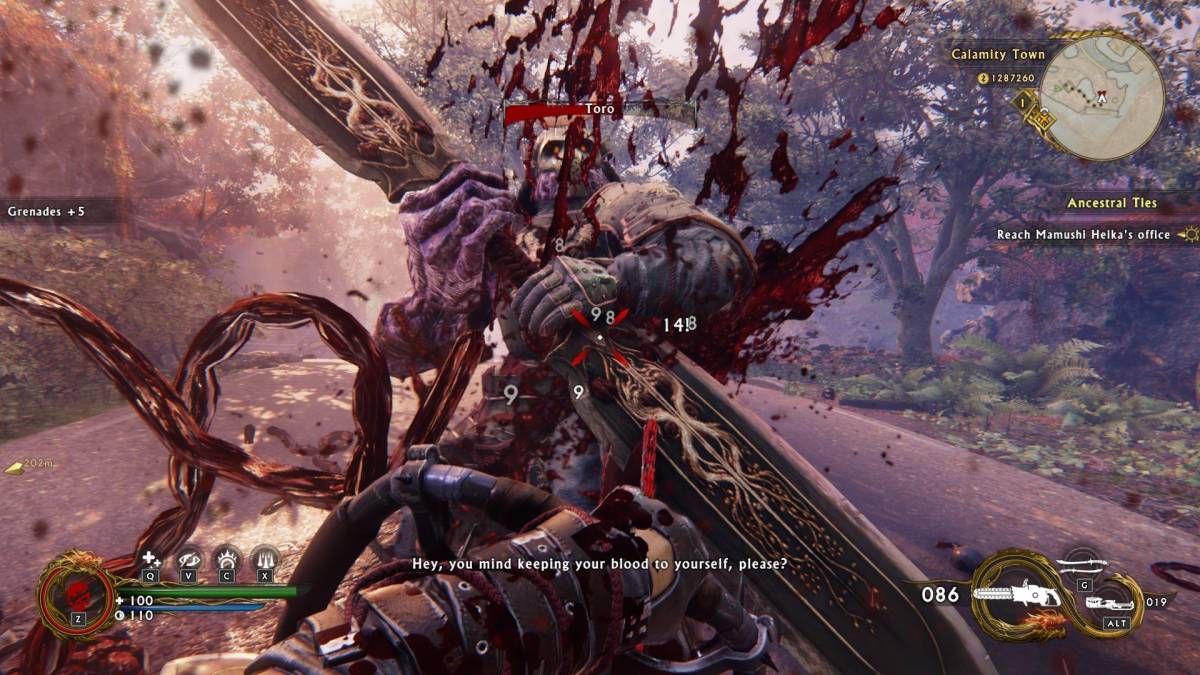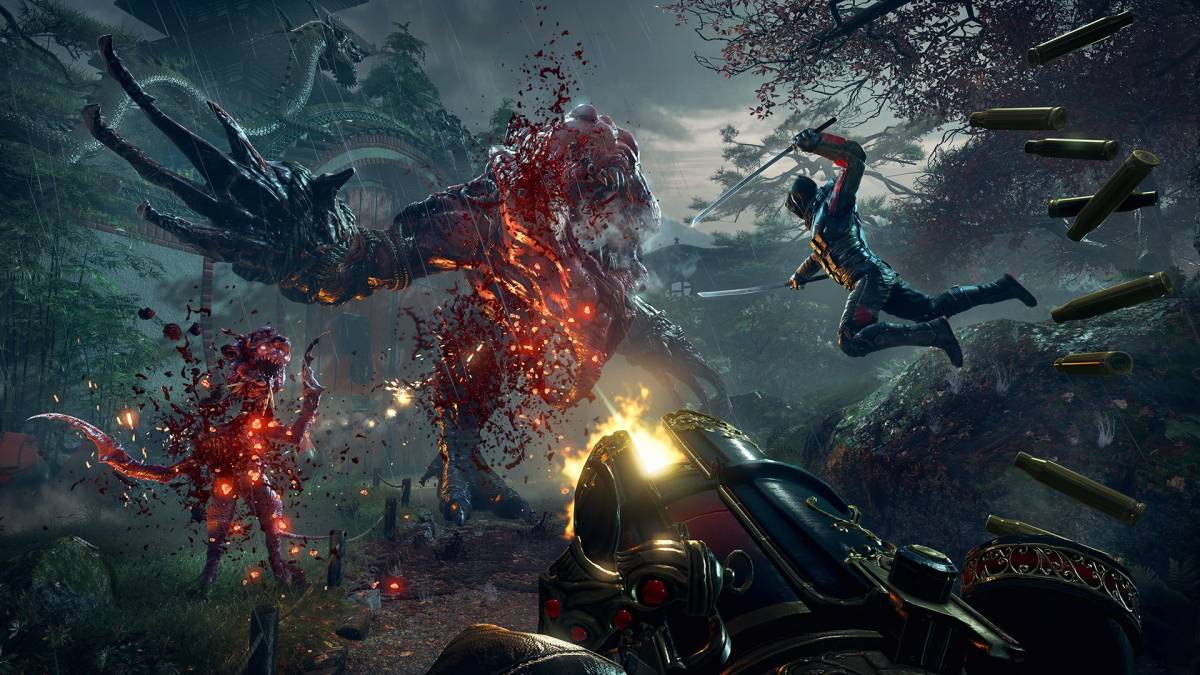Shadow Warrior 2 is the sequel to 2013’s Shadow Warrior, itself a remake of a 1997 FPS from the same team behind Duke Nukem 3D. The remake was a bit of a cult hit, and quite a pleasant surprise for me when I picked it up on a whim during a gaming drought.
The sequel picks up five years after the ending of the first game, and now has demons and humans coexisting, albeit reluctantly. Zilla Enterprises, the sinister corporation for which protagonist Lo Wang used to work, now has an even greater monopoly on every industry, with Zilla himself profiting greatly in money and power as a result of the crossover of dimensions. Lo Wang finds himself working as a mercenary, this time for the Yakuza retrieving a demonic artifact. Circumstances conspire to once again put someone’s soul inside his head, a young woman named Kamiko, Zilla’s top scientist. Their efforts to get Kamiko back into her body set the stage for the rest of the game, which has Wang traveling to several locations via Kamiko’s teleporting abilities to do main and side missions for various colorful NPC quest givers, returning every so often to the game’s hub area to turn in quests, obtain new ones and buy and sell loot and ammo. All of this can be done alone or with up to three friends in cooperative, though I played solo.

In a stark departure from the first game’s carefully crafted, linear levels, Shadow Warrior 2 plays more like a Borderlands title, with enemies exploding into a shower of money, upgrades and ammo in addition to all the blood and guts. The game makes use of procedural generation for things like enemy composition, weather and other aspects of the levels for each mission, while recycling the same basic zones. There are around five different distinct locations that are reused, despite the mission markers on the map pointing to vastly different places. These include Zilla City, an ultra-advanced cyberpunk cityscape full of harsh blues and neon, the Shadow Hills, highlands dotted with temples and abandoned villages crawling with demons and mutated animals, and Calamity Town, a suburb surrounded by treacherous forests and cliffs. It is these zones that are the starting points for the procedural generation, and you will spend the majority of your 30-35 hours running through the same areas over and over again, only at night and with slightly different enemy composition.
While the levels are beautifully rendered and oozing with style and fantastic visual design, the eye candy starts to wear thin long before the credits roll. This emptiness proves to be one of the game’s weakest points, especially when one of the most addicting parts of the first game was exploring each new level and finding secrets – here the emphasis is less on careful searching and more on blasting through the opposition to harvest their loot drops.
This loop of shooting and looting, on the other hand, is where this sequel shines. With the new loot system comes a host of new weapons and upgrades to mix and match, and tinkering with your weapon, armor and power upgrades will be how you spend most of the time you don’t spend fighting or in cutscenes. Almost every enemy will drop some sort of upgrade, more if it is a high-ranking unit, and each weapon comes with three upgrade slots (though some special weapons come with one permanently slotted with a unique one) to turn it into whatever you want. The beauty of this system over others in similar games is the sheer viability of every weapon in the game if you spend enough time upgrading it. I carried the starting revolver with me all the way into the final boss, giving it ice elemental properties early on and constantly adding better upgrades when I found them. It is the most addicting upgrade system I’ve been in a shooter in a long time. After all, I’m a writer, not a numbers guy, but I’d be lying if I said I didn’t pour over percentages and decimal points.

The weapons themselves range from real-world (ish) pistols, rifles, shotguns and launchers based on recognizable platforms such as the Desert Eagle, G-36 and Carl Gustav recoilless rifle, to demonic weapons fashioned literally from flesh and bone, to name a few. Of course, no ninja would be complete without his blade, and Shadow Warrior 2 offers dozens of melee weapons to slice, dice and crush with. From spiked baseball bats to high-tech Chi blades, getting up close and personal is certainly an attractive and effective option.
Combat itself is an absolute thrill. With an expanded skill system fed by points earned through completing missions and killing enemies, Lo Wang brings a laundry list of abilities to the table, some returning and some new additions. My personal favorite is Chi Blast, a pushback attack that once upgraded clears out all enemies around you, knocking most flat on their backs. Many skills do not give you active abilities, but rather passively boost existing ones; a certain skill that allowed my Chi Blast to affect larger, high-ranking enemies became a huge asset for melee fighting. The balancing of all of these new abilities, weapons and upgrades is perhaps the most satisfying thing about the combat, and must commended.
My biggest problem with the original game was that many of the ranged weapons felt underpowered or underutilized beyond the cannon fodder enemies – here I found myself switching between at least three or four weapons in a fight on the fly. Between my boss-killing gauss rifle, my toxic bow that caused enemies killed with it to explode into acidic clouds and all kinds of fire, electric and ice machine guns, pistols and swords, I had a weapon for every occasion, turning combat into a smooth, satisfying dance of death and destruction, bullets exploding heads and blades cutting enemies apart with the game’s dynamic dismemberment system. Despite the RPG coat of paint, the game is still an FPS at heart, and making use of your entire arsenal is key to success and enjoyment.

Aside from the addition of certain abilities, the removal of stamina adds another layer to the combat in that you can slide-dodge in any direction as much as you want – and trust me, you’ll want to. Shadow Warrior 2 ramps up the difficulty considerably (though artificially), offsetting the new toys and abilities with sometimes ludicrous amounts of enemies. This can sometimes be frustrating, as you retreat from one group of enemies or a boss who has you on the ropes only to run into more who pop out of the ground or teleport in suddenly. On several occasions, I was even attacked immediately upon teleporting into the mission area, unable to fight back as the “landing” animation finished playing out. This is really the worst part about the combat – the challenge always comes from the number of enemies and their high health, not from any particularly devious behavior or overtly-threatening attacks or abilities – the price of procedural generation over a manually curated experience.
For example, nearly every mission has a “mini-boss,” a unique, named variant of an existing enemy type who is much larger and has more health. While an interesting idea at first, every one of these fights boils down to the same exact pattern regardless if it’s a cyborg soldier, demonic shaman or a giant mutant. Each battle feels like a chore to grind for XP and achievements instead of the epic encounter it should be. This coupled with the seemingly arbitrarily assigned elemental resistances and vulnerabilities of the enemies (which can only be seen when aiming directly at them) makes some encounters, especially late-game, frustrating and disappointing when compared to how slick and satisfying most of the combat is. It would have been more engaging and strategic to give certain enemy types fixed vulnerabilities and resistances, putting it on the player to remember what to use on which foe, instead of the current system where it is all random.
Like the environments, the enemies are another standout in the visual department, from Zilla’s clean white cyborg army to my personal favorites, the Toros and Hammerheads, humanoid demons clad in samurai armor wielding bladed staves and huge swords, respectively. Developer Flying Wild Hog really took the idea of “samurai-meets-cybperunk-meets-demons” aesthetic and ran with it, and the result is a setting and world that is unlike any other I’ve seen in a video game, populated by instantly recognizable foes that are just plain cool to see in action.
With such a rich, intriguing setting, it is a shame that the story is without a doubt the weakest part of Shadow Warrior 2. The first game had a surprisingly involving story steeped in lore and mysterious supernatural happenings, with mercenary and thug Lo Wang going from dealing with Yakuza soldiers to literal demons. This time around the story is told through wordy cutscenes and internal conversations with Kamiko, all seen from the same flat first-person perspective as Wang stands there bantering, sometimes gesturing slightly with his hands. Several characters return from the first game, many of them demons or villains now trying to find their way in the new world. Every interaction plays out more or less the same – Wang shows up, insults them with jokes and put downs that have about a 50/50 chance of actually being funny, gets a mission, then insults them again and leaves.
Much like the random generation of the levels, this repetition quickly grows tiresome, as does the endless parade of sophomoric humor and mean-spirited comments. By no means was I offended by any of it, just disappointed. The first game had some genuinely good character moments and story developments between the dick jokes and sarcastic quips, giving it a cheesy action movie feel; the sequel just feels like a never-ending train of hit-or-miss innuendos with almost no normal interactions.

This is exemplified with Wang’s interactions with Kamiko, the voice in his head for most of the game. Right up until the last few story missions, all of her dialogue with Wang is (deservedly) vitriolic and spiteful, with every conversation boiling down to Kamiko calling Wang stupid, thuggish or perverted and Wang telling her to shut up or making another sex joke. Contrast with Wang’s dynamic with Hoji in the 2013 game, where between their buddy action movie quips, banter and insults were some moments of genuine interaction as the two became united in their quest, with Wang even showing concern for Hoji in later parts of the game.
By the end of the first game, their rapport feels earned; here, the way Kamiko and Wang end up doesn’t feel like the sensible progression of their dynamic. Kamiko’s attitude towards Wang in-character may be justified to an extent, but it sure doesn’t make for a fun 30+ hours. Coupled with the abrupt ending and disjointed progression of the narrative through the POV cutscenes, Shadow Warrior 2 fails to live up to its predecessor in the story department. There are some interesting but entirely optional diaries, news reports and fables that can be found as loot that expand on NPC backstories, detail events during the collision of the two worlds between the games and relate legends, but stopping to read them breaks the flow of the game. Fortune cookies make a return too, combining real quotes by literary and philosophical figures with original material – collecting them provides more consistent amusement than the narrative itself.
Ultimately, Shadow Warrior 2 is a fantastic, unique shooter experience with perhaps the most satisfying first-person melee combat system ever devised, and a diverse arsenal of weapons and abilities that encourages experimentation and making each battle into a spectacle. If you can deal with the sacrifice of an interesting narrative and some annoyances with repetition and artificial difficulty linked to the procedural generation, you’ll find dozens of hours of bloody good fun here.
Some of the coverage you find on Cultured Vultures contains affiliate links, which provide us with small commissions based on purchases made from visiting our site. We cover gaming news, movie reviews, wrestling and much more.



